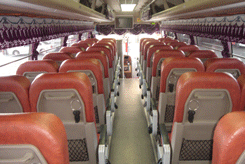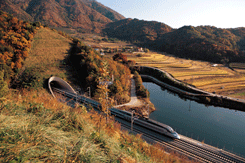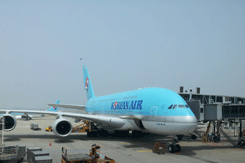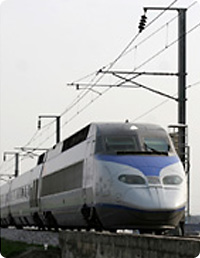Transportation
 |
 |
 |
Public transportation system in the metropolitan areas of Korea, especially Seoul, is conveniently intertwined. Many make use of the public transportation system which includes subways, buses and taxies. There are also special transportation passes such as the T-money or Mpass which allows you to make easy transfers between subways, buses and cabs all with just one card.
Domestic air
Korea has an excellent domestic flight networks linking nearly 20 cities and currently served by six carriers, Korean Air, Asiana Airlines, Jin Air, Air Busan, Jeju Air, and Eastar. You can get to any city in the country within an hour from Seoul.
Taxi
There are three different types of taxies; Regular, Deluxe, and Large (Van). Taxi stands are around in the large cities, but you can occasionally catch one on the street by hailing.
Taxies are operating in the area of their business precinct. Seoul taxies are only in Seoul and as such in Busan, other cities or provinces. But, there is an exception only when one hires taxi. If not hired, they are not allowed to pick up passengers in other license precinct. When you make a trip to the neighboring cities or towns, you can simply pay by meter. But, to a considerable distance from where you catch, fare negotiation is still a common practice. The given taxi information below is based on Seoul.
Please note the taxi fares and information given below are subjecto to vary by the nature of the fare increase. .
Regular Taxi
Regular taxies are usually grey in color and recognizable by the blue or white sign on the roof. They seem to dart in and out of traffic at what appears to be appalling speeds. They are quite reliable. The fare is by the meter. Currently, the basic fare starts 3,800 won. A 20 percent late-night surcharge is added between the hours of midnight and 4 a.m.
Deluxe Taxi
Deluxe taxies are black with a yellow sign on the top. The basic rate is 5,000 won for the first three kilometers and do not have an additional nighttime fee.
Large (Van) Taxi
Passengers who are traveling in a large group or have excess baggage may choose to take a van taxi. These taxies have the same rate system as the Mobeom taxi and are the same color as deluxe taxi (black with yellow lettering). They are available on call, and, depending on the company dispatched, a 1,000 won dispatching fee may apply.
International Taxi
Launched in May 2009, the service is based on reservation, however, not required if taxies are in waiting. Cabs with “English” signs mean that the driver can speak English. Foreign currencies are not accepted. Major credit cards like American Express, Visa, Master, or JCB card, and rechargeable pre-paid card (upgraded T-money Card) which can be purchased at information desk at the airport.
Mode of operation: 24-hour call center reservation system
Service languages: English, Japanese, Chinese
How to use
- Website: http://internationaltaxi.co.kr
- Call center: (Tel.) 1644 2255
- Airport Information Desk (One desk in Gimpo Int'l Airport, two in Incheon Int'l Airport)
Fare choice of International by your needs: Meter fare, Zone fare (limited only to and from Seoul and Incheon International airport), or charter fare are as follow.
Meter fare
Medium
Starting fare : 3,800 KRW (up to 2km)
Distance-distance fare: 100 KRW/142m
Time-distance fare : 100 KRW/35 second
Deluxe / Large
Starting fare : 5,000 KRW (up to 3km)
Distance-distance fare: 200 KRW/164m
Time-distance fare : 200 KRW/39 second
Zone fare
Zone A (Incheon International airport to Zone A in Seoul or vice versa)
Medium 55,000 KRW
Deluxe / Large 80,000 KRW
Zone B (Incheon International airport to Zone B in Seoul or vice versa)
Medium 65,000 KRW
Deluxe / Large 95,000 KRW
Zone C (Incheon International airport to Zone C in Seoul or vice versa)
Medium 75,000 KRW
Deluxe / Large 110,000 KRW
Charter rate
Medium sized taxi
3 hours 50,000 KRW
5 hours 80,000 KRW
8 hours 125,000 KRW
10 hours 150,000 KRW
Daily charter rate 200,000 KRW up to 12 hours
Deluxe / Large
3 hours 70,000 KRW
5 hours 100,000 KRW
8 hours 145,000 KRW
10 hours 175,000 KRW
Daily charter rate 200,000 KRW up to 12 hours
Additional hour at 20,000 KRW excluding toll and parking.
Water Taxi
These taxies are new addition and only available in Seoul. Launched in October, 2007, it provides tourists and commuters with a convenient transport alternative. The boat trip takes much faster than on the jammed roads.
The commuter service is from 07:00 to 8:30 and from 18:00 to 19:30 in ten minutes interval. Currently, a total of 15 taxi stops along the Han River are in operation. The taxi accommodates 7 passengers. It can also be hired except busy commuting hours.
City Buses
Almost large cities in Korea are served by an excellent bus system. In the city, buses are plainly numbered and run frequently to most destinations. Seoul 's city bus network is remarkable. There are 8,500 buses running 400 different routes every 5 to 10 minutes every day. In Seoul, the buses are divided into various color groups based on their routes. Green buses are ones that go a route that only accesses a select number of neighborhoods in one part of the city. It serves routes between subway stations and nearby residential areas/main bus lines. Blue buses, on the other hand, go from nearly one side of the city to another. It serves the major trunk roads between downtown Seoul and satellite cities of Seoul. The red buses go outside of Seoul and into surrounding areas. Yellow bus (Circular Line) serves circular belt roads in the downtown and major metropolitan area. The fare is cheap, but the buses are extremely crowded during peak rush hours. It is wise to prepare the correct fare at busy hours to avoid the hassle with change. Fare in cash or T-money card.
Subway
Seoul has a comprehensive subway that will get you easily and quickly to almost any part of the city. With 16 lines covering total distance of 493Km, it provides convenient connections to 390 stations. The transit stations are marked with a Daeguk on the map, a circle balanced in 3 different colors of red, yellow and navy blue, or numbered in the circle the lines heading to. Subway lines are identified by colors, and operate with a time interval of 3 to 5 minutes with some exceptions from 05:30 until very close to midnight, but you should keep in mind that you are ready in time for the last one. The tickets are purchased from the ATVM or at the ticket booth. The fares could vary depending on your destination station. Prepaid transit cards are recharged allowing passengers to use them until the balance on the card is exhausted, and add values afterwards. The subway is increasingly popular as a means to get around. The fare is very reasonable. You simply go to the ticket window, state your destination, pay the fare and get a paste board ticket. Validate the ticket at the turnstile with the lighted arrow. All of the stops are identified in Korean and in English with numbers. Bicycle is now admitted. If all else fails, you can always ask. Koreans are very helpful and will reach your destination. The subway is also in operation in Busan, Daegu, Daejeon and Gwanju.
Trains
Riding train is a wonderful way to discover Korea without having to worry about the traffic. There are several trains to choose: Korea Train Express (KTX) with 967 seats is the fastest and most comfortable way to get to major cities like Cheonan, Daejeon, Daegu, Busan, Gwangju, and Mokpo. The KTX started its operation in April, 2004. Two other classes are Saemaul and Mugungwha running slower. Note that the reservation system for all trains currently allows you to book one month advance of your travel. The luggage space in all passenger trains is limited - flight carry-on size will best fit to them.
Express Buses
Korea has 2,800Kms of highway network. You will get to the most of the cities in Korea within 6 hours by express bus. Today, Seoul has 4 terminals serving transportations to the countryside. They are Gangnam, Nambu, Dong Seoul and Sangbong Terminal. Gangnam Terminal or Seoul Express Bus Terminal is the major bus depot and is divided into two terminals: Gyeongjubuseon and Honam-Yeongdongseon. Gyeongjubuseon links south and southeastern region, while Honam- Yeongdongseon for southwestern and eastern region. Nambu terminal is for the buses heading for central region including some of the southeastern cities, and Sangbong Terminal for the north and northeastern cities and towns. Busan has two terminals and links major cities around the country. Buses normally operate 06:00 - 19:00 for the long distances, while 06:00 - 21:00 for the short distances. In addition, night buses are increasingly in operation and charges little more than daytime service.
Airport Limousines (Incheon International Airport)
The airport limousine is the most common way of your transportation from Incheon International Airport to major hotels in Seoul and other cities around Korea.
Listed below is an example of KAL limousine service among many other bus lines.
City Hall Line (6701)
Incheon International Airport - Koreana Hotel - Seoul Plaza Hotel - Westin Chosun Hotel - Lotte downtown Hotel - Koreana Hotel - Seosomun KAL Building - Seoul Garden Hotel
Namsan Line (6702)
Incheon International Airport - Seoul Garden Hotel - Ramada Hotel & Suite - Seoul Station - Millenium Seoul Hilton Hotel - Grand Hyatt Hotel - Grand Ambassador Hotel - Silla Hotel - Yaksu Station
Gangnam Line (6703)
Incheon International Airport - Seoul Palace Hotel - Sapyeong Station - Ritz Carlton Hotel - Novotel Ambassador Gangnam - Renaissance Hotel - Best Western Gangnam Hotel - Sapyeong Station
COEX Line (6704)
Incheon International Airport - Imperial Palace Hotel (Across) - Ramada Seoul - COEX Intercontinental Hotel - Park Hyatt Hotel (Samsung Station) - IBIS Ambassador Seoul - Grand Intercontinental Hotel
Jamsil Line (6705)
Incheon International Airport - Lotte World Hotel - Dong Seoul Bus Terminal - Gwangnaru Station - Walkerhill Hotel
Gimpo Airport Jamsil Line (6706)
Gimpo Airport - Lotte World Hotel
Airport Line (6707 A)
Hyatt Regency Incheon Hotel - Inha International Medical Center - Incheon International Airport - Gimpo Airport
Songdo Line (6707 B)
Incheon International Airport - Hyatt Regency Incheon Hotel - Korea Coast Guard - Songdo Park - Songdo Bridge - Sheraton Inchon Hotel
Vehicles
Please refer to the following guidelines of the vehicle capacity.
If with luggage for airport meeting, sending, or traveling to other places for overnight
9 seat van - 3 passengers or less
12 seat van - 3 passengers or less
15 seat bus - 4 to 5 passengers
31 seat bus - 6 to 11 passengers
45 seat bus - 12 to 30 passengers
Without luggage
9 seat van - 4 to 5 passengers
12 seat van - 6 to 7 passengers
15 seat bus - 8 to 9 passengers
31 seat bus - 10 to 17 passengers
45 seat bus - 18 to 35 passengers
Luggage truck
As usual, a luggage truck for the group of more than 30 persons when on airport meeting or sending service is strongly recommendable as Korean bus trunk will not be able to accommodate your luggage.
And likewise, when travelling for overnight to the countryside, the tourist bus and luggage truck move together.
Ferry
For the relaxed pace travelers, boat trip to Jeju and off shore islands are recommendable. Hydro foil links between Jeju and Mokpo, the southernmost port of the mainland in two hours, however ferry takes well over than 10 hours from Busan to Jeju, and 5 hours from Mokpo to Jeju or vice versa.
Driving in Korea (Right hand traffic)
Driving can be an exciting and effective way of getting around Korea. Extensive road and expressway networks are available, which means you can visit every corner of the country easily. Yet, it is indeed a frustrating experience if you do decide to venture out. Most Koreans are in their inimitable aggressive style and have little or no respect for lane markings. Roads are marked in both Korean alphabet and English, so it is not as difficult as it could be to find your destination. One key to successful driving in Korea is to have a map.
Please keep the followings in mind when driving in Korea
- You must be over 21 years of age
- Always carry your international driver license
- Possess a valid passport.
- Fasten seat belt
- No ALCOHOL
- No cellular phone
- No DMB
- Children often raise their hands in the air as they cross the street. They would cause automobile to stop
- Whenever space is provided, they often cut in which is most frustrating
- Do not drive on the lane permanently marked in blue paint. It is reserved for public buses
- Most Koreans seldom yield the right-of-way, much less of giving way to traffic already in a circle






